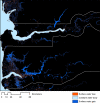Achieving global malaria eradication in changing landscapes
- PMID: 33530995
- PMCID: PMC7856737
- DOI: 10.1186/s12936-021-03599-0
Achieving global malaria eradication in changing landscapes
Abstract
Land use and land cover changes, such as deforestation, agricultural expansion and urbanization, are one of the largest anthropogenic environmental changes globally. Recent initiatives to evaluate the feasibility of malaria eradication have highlighted impacts of landscape changes on malaria transmission and the potential of these changes to undermine malaria control and elimination efforts. Multisectoral approaches are needed to detect and minimize negative impacts of land use and land cover changes on malaria transmission while supporting development aiding malaria control, elimination and ultimately eradication. Pathways through which land use and land cover changes disrupt social and ecological systems to increase or decrease malaria risks are outlined, identifying priorities and opportunities for a global malaria eradication campaign. The impacts of land use and land cover changes on malaria transmission are complex and highly context-specific, with effects changing over time and space. Landscape changes are only one element of a complex development process with wider economic and social dimensions affecting human health and wellbeing. While deforestation and other landscape changes threaten to undermine malaria control efforts and have driven the emergence of zoonotic malaria, most of the malaria elimination successes have been underpinned by agricultural development and land management. Malaria eradication is not feasible without addressing these changing risks while, conversely, consideration of malaria impacts in land management decisions has the potential to significantly accelerate progress towards eradication. Multisectoral cooperation and approaches to linking malaria control and environmental science, such as conducting locally relevant ecological monitoring, integrating landscape data into malaria surveillance systems and designing environmental management strategies to reduce malaria burdens, are essential to achieve malaria eradication.
Conflict of interest statement
The authors declare no competing interests.
Figures




References
-
- WHO . World Malaria Report 2019. Geneva: World Health Organization; 2019.
-
- Global Malaria Programme . WHO Malaria Terminology (updated 2019) Geneva: World Health Organization; 2016.
-
- WHO . Global technical strategy for malaria 2016–2030. Geneva: World Health Organization; 2015.
-
- WHO . Malaria eradication: benefits, future scenarios and feasibility. A report of the Strategic Advisory Group on Malaria Eradication. Geneva: World Health Organization; 2020.
Publication types
MeSH terms
LinkOut - more resources
Full Text Sources
Other Literature Sources
Medical

